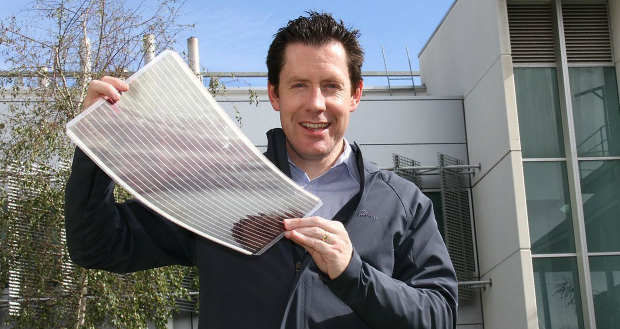
A new solar cell printer installed at the CSIRO is printing the largest flexible plastic solar cells in Australia using traditional screen printing methods. Researchers say the new printer, worth $200,000, is a big step up for the team, allowing them to print organic photovoltaic cells ten times larger than before. The technology has been steadily developing with the help of government funding, and researchers say the applications could be extensive for Australia’s energy future.

Dr Scott Watkins holding a sheet of flexible solar cells
In three years the Victorian Organic Solar Cell Consortium (VICOSC), a collaboration between the CSIRO, University of Melbourne, Monash University and industry partners, has gone from making cells the size of a fingernail to cells 10cm square, and now 30cm wide. VICOSC project coordinator and University of Melbourne researcher Dr David Jones says the machine uses existing printing techniques, making it an accessible technology. He says, “We are using the same techniques that you would use if you were screen printing an image on to a t-shirt.” Using semiconducting inks, the researchers print the cells straight onto paper-thin flexible plastic or steel. The cells are the size of an A3 sheet of paper and output 10 to 50 watts of power per square metre. With the ability to print at speeds of up to ten metres per minute, the machine can produce one cell every two seconds. CSIRO materials scientist Dr Scott Watkins says printing cells on such a large scale opens up a huge range of possibilities for pilot applications. The cells will initially be used to power consumer devices and small integrated electronics, but the researchers have ideas on a grander scale for the long term. He says, “There are so many things we can do with cells this size. We can set them into advertising signage, powering lights and other interactive elements. We can even embed them into laptop cases to provide backup power for the machine inside.”
As the researchers continue to scale up their equipment, they say the possibilities will expand. Jones says, “Eventually we see these being laminated to windows that line skyscrapers. By printing directly to materials like steel, we will also be able to embed cells onto roofing materials.” The scientists predict that the future energy mix for the world, including Australia, will rely on many non-traditional energy sources. Watkins says, “We need to be at the forefront of developing new technologies that match our solar endowment, stimulate our science and support local, high-tech manufacturing. “While the consortium is focused on developing applications with current industrial partners there are opportunities to work with other companies through training programs or pilot-scale production trials.” As part of the consortium, a complementary screen printing line is also being installed at nearby Monash University. Combined, the CSIRO says the technologies will make the Clayton Manufacturing and Materials Precinct one of the largest organic solar cell printing plants in the world. The consortium has also previously developed processes for printing solar cells that use spray coating, reverse gravure and slot-dye coating as well as screen printing. While it is currently only purchasing materials on a research scale, when scaled up the researchers anticipate that component costs will be significantly lower to potentially achieve pricing around $1 per watt.
Comment below to have your say on this story.
If you have a news story or tip-off, get in touch at editorial@sprinter.com.au.
Sign up to the Sprinter newsletter


